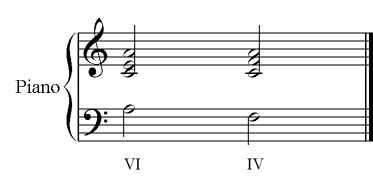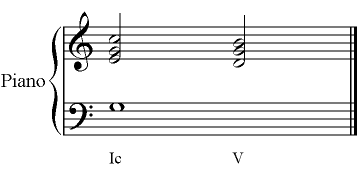The end of a phrase, called a cadence or, in jazz, a turnaround, is often a point where the music seems to pause, hesitate or stop. If you were singing the line or playing it on a wind instrument you might breathe here. The interruption in the music's flow may result from the shape of the melodic line, or, more commonly, from a particular sequence of chords associated with the melody. Some writers describe a cadence as a point when the underlying tension in a moving line of music relaxes but this is quite simplistic as sometimes a cadence can derive its 'effect' from relaxation postponed.
We have already described how, by writing in a certain way, composers will give a piece a strong sense of key. When describing triads and chords, we mentioned that some triads and some chords are more 'stable' than others. 'Unstable' chords and triads want to resolve to more stable ones. The most 'stable' chord will be the tonic chord and so any sequence ending with the tonic chord will seem to have reached a 'completion' while those ending on other chords will seem still to be unresolved.
This is the fundamental difference between the perfect and plagal cadences (where both end on the tonic chord and are called, collectively, authentic cadences) and the other two, the interrupted and imperfect, which do not.
Let us look at the fundamentals of a perfect cadence, also called the full close.
The perfect cadence gets its power from two particular note sequences.
To summarize, the perfect cadence is always authentic - it uses a V-»I or V-»i progression, where both triads are in root position, and the tonic note of the scale is in the highest part. This is the most decisive cadence and the I (i) chord is felt to be very conclusive. Its strongest version is in the extended cadence IV-»Ic-»V-»I, which is commonly used as the final ending in long pieces of music. The perfect cadence can be seen as analogous to a full-stop.
Writers notate this sequence V-»I or V-»i.

To listen to these four perfect cadences press the play button displayed below.
| Perfect Cadences | |||
There is a second sequence of chords that incorporates both the features we mentioned above and this uses a dominant 7th in place of the dominant chord above. This makes the dominant, which is only 'slightly' unstable and therefore only weakly drawn towards the tonic, more dissonant because the 7th and therefore in greater need of resolution - the dominant 7th chord is more 'unstable' than the dominant chord.
In the key of C major or C minor, the dominant 7th is the minor 7th in the key of G major, F natural. The F natural wants to resolve to E in C major or to E flat in C minor.

To listen to these four perfect cadences using the dominant 7th press the play button displayed below.
| Perfect Cadences with Dominant 7th | ||
Writers notate this sequence V7-»I.
When the perfect cadence ends a piece of music both the dominant and tonic chords should be in root position. Note that we don't say must as some writers of theory books do. Composers like to break the rules! However the chord sequence is generally most effective when both chords are in root position.
When the cadence occurs in the middle of a piece, there is no need to use it in its 'strongest' form. Either chord may be inverted - even both - and whether the dominant has a 7th or not. Notes in both chords can be doubled although it is better not to double the 7th in the dominant chord.
The plagal or church cadence replaces the dominant, or dominant 7th chord, with a subdominant chord, that is a chord on the 4th. The effect is weaker than in the perfect cadence but was popular in music of the 16th-century. Certainly, both the perfect and plagal cadences, give a feeling of closure when used at the end of pieces of music. The absence of the leading note in the subdominant chord makes it weaker than the dominant chord as a preparation for the tonic chord.
The plagal cadence is usually defined as one whose penult is IV and whose final is I (or whose penult is iv and whose final is i).
Some theorists have widened its definition to include cadences whose penult is on the subdominant (flat) side of the tonic e.g. ii-»I.
The term is best used to describe cadences in which the penult contains the tonic degree. The only triads which contain the tonic degree (except for I and i) are IV, iv, VI and vi. The vi triad is not found as the penult in any effective cadence and so it can be ignored.
This gives the following endings: IV-»I, iv-»i, iv-»I, IV-»i, VI-»i.
All of these cadences have a penult which can also harmonise the tonic note. This is why the plagal cadence is sometimes called the "Amen cadence" because of its use at the end of hymns.
The plagal cadence is frequently used after a perfect cadence, because it is not as tonally decisive as the perfect cadence.

To listen to these four plagal cadences press the play button displayed below.
| Plagal Cadences | ||
Writers notate this sequence IV-»I.
Both the perfect and plagal cadence end on the tonic chord. The imperfect cadence ends on the dominant chord which can be approached from any other chord, the most common being I, II, IV or VI.
The imperfect cadence is also always authentic, but now the triads are not in root position, and/or the tonic is not in the highest part. When the tonic note is not in the highest part, it slightly weakens the decisiveness of the conclusion.
When the V is inverted, it weakens the decisiveness and strength of the progression.
When the I (i) is inverted, it weakens the conclusiveness of the tonic to a much greater degree. Although the key centre is strongly established by this progression, it does not provide a proper sense of conclusion because the inversions of the triads are not, in themselves, stable entities. Such a cadence is often used where a perfect cadence would seem overly emphatic - it does not check the flow of the music too severely. This type of cadence is perhaps analogous to a comma.
We give examples of each below.

To listen to these four imperfect cadences press the play button displayed below.
| Imperfect Cadences | ||
Interrupted/Deceptive Cadence :: 
The expectation that a dominant chord moves to a tonic chord, thus producing a perfect cadence, is very strong. For this reason, if a dominant chord is followed by any other chord, the feeling is one of 'interruption'. So an interrupted cadence is a dominant chord followed by any chord except the tonic.
Sometimes the term 'deceptive' is used to describe these progressions. The two terms, 'deceptive' and 'interrupted' are generally considered to be synonymous, but to make a distinction between them, we give a clearer definition for two similar, but different, types of cadential progression. These cadences are the same as the authentic, except that instead of resolving from V to I (i) they resolve to another chord. The effect of this progression is dependent on the chord to which they resolve.
Deceptive
When V resolves to vi it sounds like a very effective resolution because vi is able to function as a genuine tonic - i.e. as a chord of rest and resolution. In this way this cadence is genuinely deceptive - the ear is expecting something, but it is given something else which has such a similar function that it is not easily detected - the ear is fooled.
There are other chords which may be deemed to be deceptive finals - IVb and I7 are good examples.
The IV is usually used in its first inversion and sounds similar to vi.
I7 sounds like I but it has a different function - as a dominant seventh it cannot function as an effective tonic (in common practice tonal harmony) and seeks resolution to a triad a fifth below.
Due to their similarity to genuine tonics both these chords have been introduced deceptively. Any other chords which bear similarity to the genuine tonics of I, i and vi, can be introduced deceptively.
Interrupted
When the V chord resolves to a chord which bears no relation to a true tonic, the cadence can be described as interrupted. It sounds like a normal cadence, but it suddenly changes tack and instead of resolving it moves to a completely different place. The cadence has been interrupted.
There is no distinction made between the interrupted and deceptive cadences in conventional music theory; they are simply synonyms and either will be chosen at the behest of the author.
We give some examples below.

To listen to these four interrupted cadences press the play button displayed below.
| Interrupted Cadences | ||
There are clearly a considerable number of possible cadences not included in the four discussed above. The 'six-four' cadence or VI-»IV cadence, is interesting and we illustrate it below.

To listen to a 'six-four' cadence press the play button displayed below.
| Six-Four Cadence | ||
Cadences are normally found where the second chord is rhythmically stronger than the first. When the first chord is stronger than the second, the cadence is called 'feminine'. Music from the period of Haydn and Mozart used the progression Ic-»V, i.e. second inversion tonic chord to dominant chord, so often that one might call it 'characteristic' and is sometimes called a 'half' cadence. It should be noted that this pattern produces two chords with the same bass note in both chords.

To listen to a feminine ending press the play button displayed below.
| Feminine Ending | ||
When discussing music in terms of phrases (we discussed phrases in lesson 21) one meets two particular terms, antecedent and consequent. Sometimes these are called respectively 'question' and 'answer' and occur one after the other.
The antecedent, or 'questioning' phrase is the first musical statement. It usually ends with a half cadence, the feminine ending we discussed above, or an imperfect cadence. The phrase pauses momentarily on the half cadence or imperfect cadence, but it has the need to continue so the musical thought can be completed.
The completion is provided by the consequent phrase, an 'answering' phrase. It occurs after the antecedent phrase. The consequent phrase usually ends with a perfect cadence (authentic or plagal).
We summarise the different cadences in the table below.
| cadences, a progression of chords at the end of, or the end of a section in a musical work: | ||
| perfect cadence full close final cadence full close cadence complete cadence some do not consider a cadence to be completely perfect unless the melody ends on the tonic and both chords are in root position | authentic | for example, V-»I |
| true plagal church cadence amen cadence complete cadence | authentic | for example, IV-»I |
| plagal cadence see note below about 'half' and 'half-close' | authentic | for example, I-»IV-»I |
| imperfect cadence half close cadence half cadence semi-cadence 'half close' and 'half' are sometimes applied to 'plagal' cadences which are authentic but in which the chord is not in root position, or the melody does not end on the tonic | not authentic | for example, II-»V |
| interrupted cadence deceptive cadence false cadence | not authentic | for example, V-»VI |
| phrygian cadence a special type of 'half' cadence that only occurs in minor keys | not authentic | for example, iv6-»V |